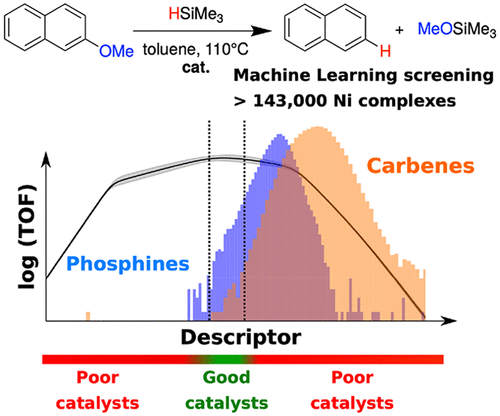当前位置:
X-MOL 学术
›
ACS Catal.
›
论文详情
Our official English website, www.x-mol.net, welcomes your
feedback! (Note: you will need to create a separate account there.)
Data-Driven Advancement of Homogeneous Nickel Catalyst Activity for Aryl Ether Cleavage
ACS Catalysis ( IF 11.3 ) Pub Date : 2020-05-26 , DOI: 10.1021/acscatal.0c00774 Manuel Cordova 1 , Matthew D. Wodrich 1 , Benjamin Meyer 1, 2 , Boodsarin Sawatlon 1 , Clémence Corminboeuf 1, 2
ACS Catalysis ( IF 11.3 ) Pub Date : 2020-05-26 , DOI: 10.1021/acscatal.0c00774 Manuel Cordova 1 , Matthew D. Wodrich 1 , Benjamin Meyer 1, 2 , Boodsarin Sawatlon 1 , Clémence Corminboeuf 1, 2
Affiliation

|
The increasing urgency to make chemical processes more environmentally friendly while continuing to derive the chemicals required for modern society from renewable resources requires the development of a forthcoming generation of synthetic processes and the catalysts needed to facilitate these reactions. Recently, applications of machine-learning (ML) algorithms involving catalysis have begun to appear with increasing frequency, as they constitute an attractive pathway both for discovering prospective species and identifying trends surrounding catalytic behavior, principally because the number of potential catalysts that can be examined greatly exceeds those found in more traditional experimental or theoretical approaches. Here, we harness a data-driven approach powered by ML in tandem with molecular volcano plots to estimate the activity of over 143,000 homogeneous nickel catalysts bearing phosphine and N-heterocyclic carbene ligands for the reductive C(sp2)–O cleavage reaction in aryl ether compounds, an important step in the degradation of biomass (lignin) into industrially useful feedstock chemicals. Our computational workflow reveals that a vast majority of Ni-phosphine and Ni-carbene catalysts are not ideally tuned to facilitate this reaction. An analysis of those species identified as being the most promising uncovers a clear catalytic design strategy that can be exploited in an experimental setting to enhance the rate of reductive C(sp2)–O cleavage of aryl ether compounds.
中文翻译:

芳烃裂解均相镍催化剂活性的数据驱动进展
在使化学过程更加环境友好的同时,不断从可再生资源中获取现代社会所需化学物质的紧迫性,要求开发出即将到来的合成过程,并需要促进这些反应的催化剂。最近,涉及催化的机器学习(ML)算法的应用已开始以增加的频率出现,因为它们构成了寻找潜在物种和识别催化行为趋势的诱人途径,主要是因为可以检查的潜在催化剂的数量大大超过了在更传统的实验或理论方法中发现的那些。这里,2)–芳基醚化合物中的O裂解反应,这是将生物质(木质素)降解为工业上有用的原料化学物质的重要步骤。我们的计算工作流程表明,绝大多数Ni-膦和Ni-卡宾催化剂均未经过理想的调整以利于该反应。对那些被确定为最有前途的物种的分析发现了明确的催化设计策略,可以在实验环境中利用该策略来提高芳基醚化合物的还原性C(sp 2)-O裂解速率。
更新日期:2020-07-02
中文翻译:

芳烃裂解均相镍催化剂活性的数据驱动进展
在使化学过程更加环境友好的同时,不断从可再生资源中获取现代社会所需化学物质的紧迫性,要求开发出即将到来的合成过程,并需要促进这些反应的催化剂。最近,涉及催化的机器学习(ML)算法的应用已开始以增加的频率出现,因为它们构成了寻找潜在物种和识别催化行为趋势的诱人途径,主要是因为可以检查的潜在催化剂的数量大大超过了在更传统的实验或理论方法中发现的那些。这里,2)–芳基醚化合物中的O裂解反应,这是将生物质(木质素)降解为工业上有用的原料化学物质的重要步骤。我们的计算工作流程表明,绝大多数Ni-膦和Ni-卡宾催化剂均未经过理想的调整以利于该反应。对那些被确定为最有前途的物种的分析发现了明确的催化设计策略,可以在实验环境中利用该策略来提高芳基醚化合物的还原性C(sp 2)-O裂解速率。











































 京公网安备 11010802027423号
京公网安备 11010802027423号